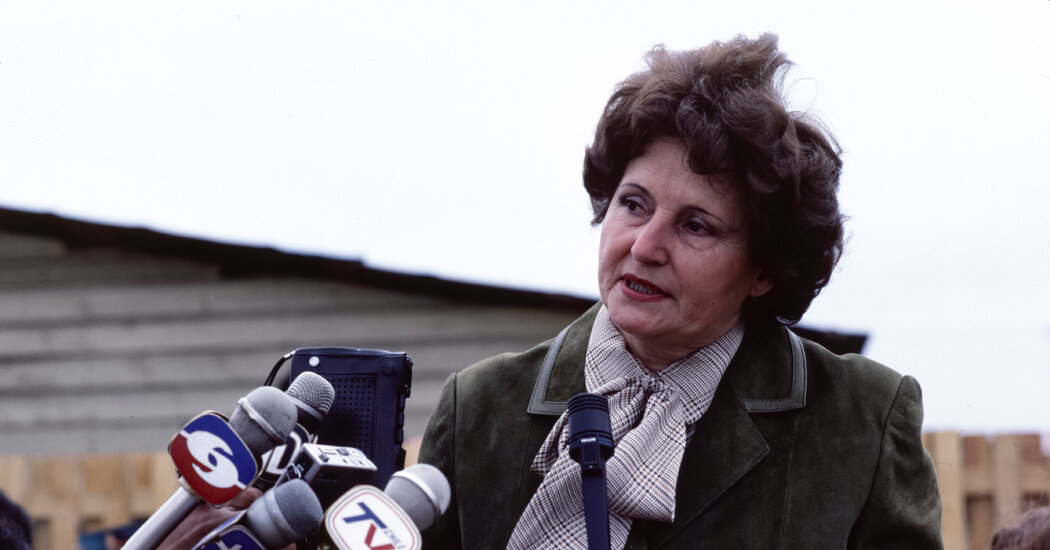Lucía Hiriart, who as the wife of the Chilean dictator Augusto Pinochet was said to have been a powerful influence on him, died on Thursday in the Lo Barnechea area of Santiago. She was 98.
Her death was announced by her son Marco Antonio Pinochet.
Ms. Hiriart was one of the defining figures of 20th-century Chile, but opinions about her were mixed. Her longevity, and her role in her husband’s regime led many to revile her as a sinister, ghoulish figure known simply as “the old woman.” Others maintain that she was an eminent philanthropist who dedicated her life to the service of the Chilean people.
Her health had been kept a closely guarded secret since the death of her husband in 2006, and her public appearances were few and far between.
Ms. Hiriart was said to wield extraordinary power in the presidential palace, La Moneda, during her husband’s 17-year dictatorship.
She was believed to have had a hand in the dismissal of ministers, and General Pinochet acknowledged that she pushed him, when he was the head of the armed forces, to participate in the 1973 coup d’état that deposed Chile’s socialist president, Salvador Allende.
“One evening, my wife took me to the bedroom where our grandchildren were sleeping,” General Pinochet wrote about the eve of the coup in a memoir, “Camino Recorrido, Memorias de un Soldado.” “She turned to me and said, ‘They will be slaves because you haven’t been able to make a decision.’”
Soon after that, General Pinochet signed on to the coup attempt, which ousted President Allende on Sept. 11, 1973, in a swift attack on La Moneda. He was installed at the head of the military junta, and his dictatorship ruled Chile until the country’s return to democracy in 1990.
When the four branches of the armed forces — the army, air force, navy and police force — agreed to rotate leadership following the coup, it was Ms. Hiriart who pushed her husband to be the first leader of the junta. It was a role he never relinquished.
“La Moneda functioned more or less like a monarchy during the dictatorship, with Hiriart and Pinochet as queen and king,” the Chilean journalist Alejandra Matus, the author of “Doña Lucía,” an unauthorized biography of Ms. Hiriart, said in an interview.
“Lucía Hiriart created ‘Pinochet the dictator,’” Ms. Matus said, “because if she hadn’t conspired with him, he would not even have lent his support to the coup.”
María Lucía Hiriart Rodríguez was born on Dec. 10, 1923, in Antofagasta, a city on Chile’s arid northern coastline. She was the eldest daughter of Osvaldo Hiriart, an influential politician of Basque-French heritage who would serve briefly as Chile’s interior minister in the 1940s, and Lucía Rodríguez.
The family later moved to the San Bernardo district, south of the capital, Santiago, where in 1941 she met Augusto Pinochet, an army officer eight years her senior. Much to her family’s displeasure — he belonged to a lower social class — they married two years later.
Ms. Hiriart helped to define a philanthropic role for herself as Chile’s first lady. But she also quickly developed a reputation as strong-willed and demanding.
She had more than 20 aides at her beck and call in quarters spanning the entire 17th floor of the Diego Portales building in Santiago, where the executive branch was initially based after the coup.
In 1981, she moved her offices to a wing of La Moneda, above the press center.
She later ordered Italian marble to adorn the floors of the $14 million mansion built for the couple in the foothills of the Andes, overlooking the capital. The 5,000-square-meter home, complete with a swimming pool, tennis courts and underground bunker, was never given to the couple; following a public outcry, it was given to the armed forces and used as an officers’ mess.
Ms. Hiriart was accused on numerous occasions of tax evasion, embezzlement and misappropriation of public funds.
She took over the presidency of the Centro de Madres Chile (CEMA Chile), a foundation representing the interests of Chilean mothers, which she oversaw until 2016. While she and her husband resided in southern England in the 1990s, the money used to cover General Pinochet’s living and health care expenses was said by Chilean prosecutors to have been siphoned off from the organization.
An investigation into CEMA Chile was closed in 2013, and no member of the Pinochet-Hiriart family faced charges. When CEMA Chile ceased operation in 2019, it handed 108 properties worth 7.6 billion pesos over to the state.
Among several other corruption investigations, Chile’s inland revenue service brought tax evasion charges against Ms. Hiriart and her five children in 2005 in relation to more than $21 million held in 125 accounts at Riggs Bank in Washington, under the names of the couple’s children and a variety of aliases.
Ms. Hiriart was never found guilty in that or any other investigation.
In addition to her son Marco Antonio, Ms. Hiriart’s survivors include four other children, Inés, Augusto, María Verónica and Jacqueline Marie; and many grandchildren.


